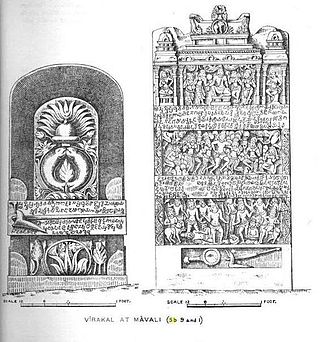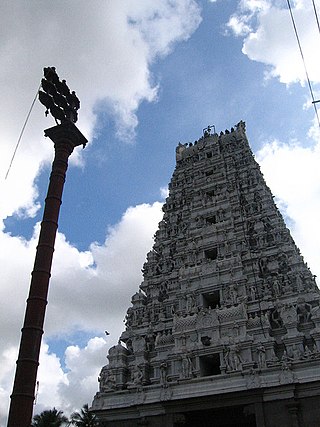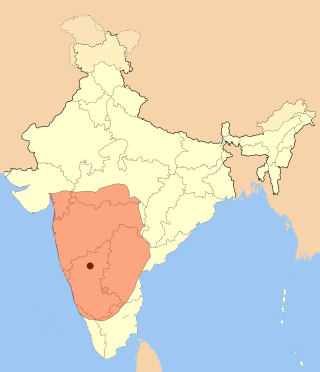Related Research Articles

The middle kingdoms of India were the political entities in the Indian subcontinent from 230 BCE to 1206 CE. The period begins after the decline of the Maurya Empire and the corresponding rise of the Satavahana dynasty, starting with Simuka, from 230 BCE. The "middle" period lasted for almost 1436 years and ended in 1206 CE, with the rise of the Delhi Sultanate, founded in 1206, and the end of the Later Cholas.

The Pandyan dynasty, also referred to as the Pandyas of Madurai, was an ancient Tamil dynasty of South India, and among the four great kingdoms of Tamilakam, the other three being the Pallavas, the Cholas and the Cheras. Existing since at least the 4th to 3rd centuries BCE, the dynasty passed through two periods of imperial dominance, the 6th to 10th centuries CE, and under the 'Later Pandyas'. Under Jatavarman Sundara Pandyan I and Maravarman Kulasekara Pandyan I, the Pandyas ruled extensive territories including regions of present-day South India and northern Sri Lanka through vassal states subject to Madurai.

The Pallava dynasty existed from 275 CE to 897 CE, ruling a significant portion of the Deccan, also known as Tondaimandalam. The Pallavas played a crucial role in shaping the South Indian history and heritage during their rule. The dynasty rose to prominence after the downfall of the Satavahana dynasty, whom they had formerly served as feudatories.

Simhavishnu also known as Avanisimha son of Simhavarman III and one of the Pallava kings of India, was responsible for the revival of the Pallavan dynasty. He was the first Pallava monarch whose domain extended beyond Kanchipuram (Kanchi) in the South. He was portrayed as a great conqueror in Mattavilasa Prahasana, a drama written by his son Mahendravarman I.

Vikramaditya II was the son of King Vijayaditya and ascended the Badami Chalukya throne following the death of his father. This information comes from the Lakshmeshwar inscriptions in Kannada dated 13 January 735 A.D. From inscriptions it has come to be known that even before his coronation, Vikramaditya II, as a crown prince (Yuvaraja), had conducted successful military campaigns against their arch enemy, the Pallavas of Kanchipuram. His most important achievements were the capture of Kanchipuram on three occasions, the first time as a crown prince, the second time as an emperor and the third time under the leadership of his son and crown prince Kirtivarman II. This is attested to by another Kannada inscription, known as the Virupaksha Temple inscription which alludes to the emperor as the conqueror of Kanchi on three occasions and reads Sri Vikramaditya-bhatarar-mume-Kanchiyan-mume parajisidor. The other notable achievement was the consecration of the famous Virupaksha Temple and Mallikarjuna Temple by his queens Lokadevi and Trilokadevi at Pattadakal. These two monuments are the centre piece of the UNESCO World Heritage Monuments at Pattadakal. Vikramaditya II was a powerful ruler and was in power for 40 years. In order to maintain peace he entered into marriage alliance with Rashtrakutas.

Jatavarman Sundara I, also known as Sadayavarman Sundara Pandyan, was a emperor of the Pandyan dynasty who ruled regions of Tamilakkam, Northern Sri Lanka and Southern Andhra between 1250–1268 CE. He is remembered for his patronage of the arts and tamil architecture, along with refurbishment and decoration of many Kovils (temple) in the Tamil continent. He oversaw a massive economic growth of the Pandyan empire. On the eve of his death in 1268 CE, the second Pandyan empire's power and territorial extent had risen to its zenith till Nellore and Kadapa by defeating Telugu Chola ruler Vijaya Gandagopala alias Manumasiddhi II of Nellore Cholas and Ganapatideva of Kakatiyas.
Dantidurga, also known as Dantivarman II was the founder of the Rashtrakuta Empire of Manyakheta. His capital was based in Gulbarga region of Karnataka. His successor was his uncle Krishna I who extended his kingdom to all of Karnataka.

The Chola dynasty was a Tamil dynasty in southern India. At its height, it ruled over an expansive maritime empire known as the Chola empire. The earliest datable references to the Chola are from inscriptions dated to the 3rd century BCE during the reign of Ashoka of the Maurya empire. The Chola empire was at its peak and achieved imperialism under the Medieval Cholas in the mid-9th century CE. As one of the Three Crowned Kings of Tamilakam, along with the Chera and Pandya, the dynasty continued to govern over varying territories until the 13th century CE.

Govinda III was greatest Rashtrakuta ruler who succeeded his illustrious father Dhruva Dharavarsha. He was militarily the most successful emperor of the dynasty with successful conquests-from Kanyakumari in the south to Kannauj in the north, from Banaras in the east to Broach (Bharuch) in the west. From the Someshvara inscription of 804 it is known that 'Gamundabbe' was his chief queen.

Vijayalaya Chola was a descendant of the Early Cholas, who revived the Chola dynasty and founded the Imperial Chola Empire. He ruled over the region to the north of the river Kaveri. Vijayalaya Chola is one of the descendants of famous Sangam age Chola king Karikala Chola. According to Anbil plates of Parantaka Chola II, Vijayalaya's predecessor is a Telugu Chola king Srikantha Choladhiraja who was ruling Renadu region and belongs to Pottapi Chola lineage and is a descendant of ancient Tamil king Karikala Chola. Vijayalaya was succeeded by his son Aditya Chola I, who laid the foundation of Imperial Chola Empire.

Vikramaditya VI became the Western Chalukya King after deposing his elder brother Someshvara II, a political move he made by gaining the support of Chalukya vassals during the Chola invasion of Chalukya territory. Vikramaditya's reign is marked with the abolishment of the Saka era and the start of the Chalukya-Vikrama era. He was the greatest of the Western Chalukya kings and had the longest reign in the dynasty. He earned the title Permadideva and Tribhuvanamalla. He had several queens who ably assisted him in administration. One of his queens, Chandala Devi, a princess from the Shilahara ruling family of Karad was called Abhinava Saraswati for her skills as an artist. Queen Kethala Devi administered the Siruguppa region and Savala Devi was in charge of an Agrahara in Naregal. According to the historian Kamath, Vikramaditya VI was a "great king who ruled over South India" and he finds a "pride of place in Karnataka history". More inscriptions in Kannada are attributed to Vikramaditya VI than any other king prior to the Vijayanagara era.

The Telugu Chodas or Telugu Cholas ruled parts of present-day Andhra Pradesh and Telangana between the 6th and the 13th centuries as samantas of Pallavas and later the Cholas. Various dynasties exist among them including Velanati, Pottapi, Konidena, Nannuru, Nellore, Kunduru etc. The earliest Choda dynasty in the Telugu area was that of Renati Chodas who ruled Renadu region in the 6th and 7th centuries. Some of the Telugu Chodas including Renati Chodas claimed descent from the early Sangam Chola king Karikala Chola.Telugu Chodas contributed much to the early development of Telugu language and are the first dynasty to use Telugu as their official language. The first and oldest Telugu inscription founded so far is Kalamalla inscription dating to 575 CE put up by Renati Chola king Erikal Mutturaju Dhanunjaya. Telugu Chodas are believed to have been migrated from Tamilakam to Andhra country due to invasion of Tamilakam by Kalabhras and increasing power of Pallavas in northern most part of Tamilakam.

Eastern Chalukyas, also known as the Chalukyas of Vengi, were a dynasty that ruled parts of South India between the 7th and 12th centuries. They started out as governors of the Chalukyas of Badami in the Deccan region. Subsequently, they became a sovereign power, and ruled the Vengi region of present-day Andhra Pradesh until c. 1001 CE. They continued ruling the region as feudatories of the Medieval Cholas until 1189 CE.

Uthiramerur is a panchayat town in Kancheepuram district in the Indian state of Tamil Nadu. It is situated 90 km south west of Chennai, the capital of Tamilnadu. It is noted for its temple inscriptions that describe a self-governance system existing around 7th to 9th century CE.
Nandivarman II was a Pallava monarch who reigned in Southern India. Sen states Nandivarman reigned from 731 CE to 796 CE and built the Vaikuntha-Perumal Temple. He was born in the country of Champa, in Simhapura into a local dynasty of Pallava origin and was elected as the Pallava monarch at the age of 13.
The political history of medieval Karnataka spans the 4th to the 16th centuries, when the empires that evolved in the Karnataka region of India made a lasting impact on the subcontinent. Before this, alien empires held sway over the region, and the nucleus of power was outside modern Karnataka. The medieval era can be broadly divided into several periods: The earliest native kingdoms and imperialism; the successful domination of the Gangetic plains in northern India and rivalry with the empires of Tamilakam over the Vengi region; and the domination of the southern Deccan and consolidation against Muslim invasion. The origins of the rise of the Karnataka region as an independent power date back to the fourth-century birth of the Kadamba Dynasty of Banavasi, the earliest of the native rulers to conduct administration in the native language of Kannada in addition to the official Sanskrit. This is the historical starting point in studying the development of the region as an enduring geopolitical entity and of Kannada as an important regional language.

The Eastern Ganga dynasty were a large medieval era Indian royal Hindu dynasty that reigned from Kalinga from as early as the 5th century to the mid 20th century. Eastern Gangas ruled much of the modern region of Odisha in three different phases by the passage of time, known as Early Eastern Gangas (493–1077), Imperial Eastern Gangas (1077–1436) and Khemundi Gangas (1436–1947). They are known as "Eastern Gangas" to distinguish them from the Western Gangas who ruled over Karnataka. The territory ruled by the dynasty consisted of the whole of the modern-day Indian state of Odisha, as well as major parts of north Andhra Pradesh, parts of Chhattisgarh and some southern districts of West Bengal. Odia language got official status in their regime following the evolution of the language from Odra Prakrit. The early rulers of the dynasty ruled from Dantapuram; the capital was later moved to Kalinganagara, and ultimately to Kataka and then to Paralakhemundi.

The Chalukya dynasty was a Classical Indian dynasty that ruled large parts of southern and central India between the 6th and the 12th centuries. During this period, they ruled as three related yet individual dynasties. The earliest dynasty, known as the "Badami Chalukyas", ruled from Vatapi from the middle of the 6th century. The Badami Chalukyas began to assert their independence at the decline of the Kadamba kingdom of Banavasi and rapidly rose to prominence during the reign of Pulakeshin II. After the death of Pulakeshin II, the Eastern Chalukyas became an independent kingdom in the eastern Deccan. They ruled from Vengi until about the 11th century. In the western Deccan, the rise of the Rashtrakutas in the middle of the 8th century eclipsed the Chalukyas of Badami before being revived by their descendants, the Western Chalukyas, in the late 10th century. These Western Chalukyas ruled from Kalyani until the end of the 12th century.
Nandivarman III was an Indian monarch of the Nandivarman II line who ruled the Pallava kingdom from 846 to 869. He was the son of Dantivarman and the grandson of Nandivarman II.
Srikantha Chola was a Telugu Chola ruler belonging to Pottapi Chola family which claims descent from ancient Tamil king Karikala Chola. He was ruling Renadu region as a feudatory of Pallavas. Srikantha was succeeded by Vijayalaya Chola.
References
- Sailendra Nath Sen (1999). Ancient Indian History and Civilization. New Age International. p. 449. ISBN 8122411983, ISBN 978-81-224-1198-0.